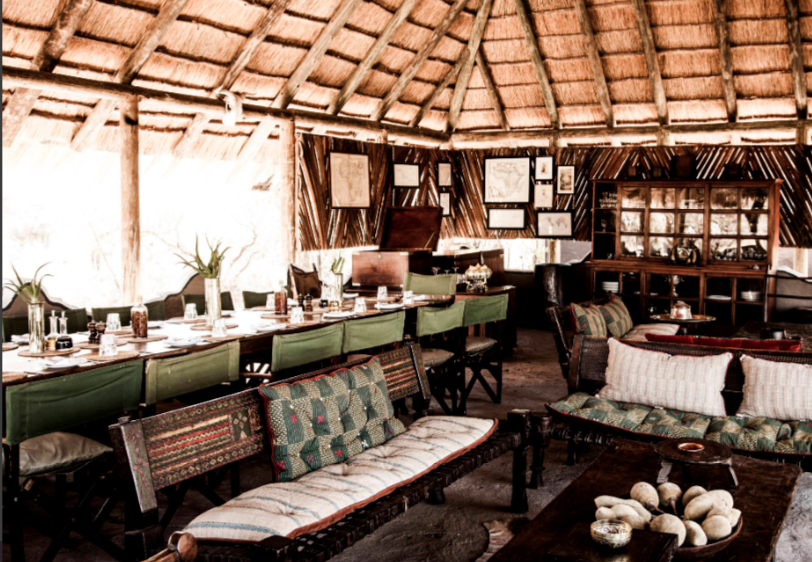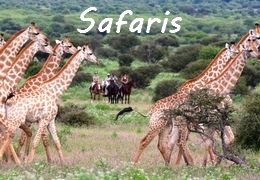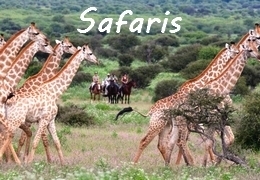-20.78179492977, 25.46416285
The Kalahari Safari takes you into the Makgadikgadi salt pans, an ancient lake that dried up around 1500 years ago. The salt-encrusted pans are dotted with giant baobab trees and separated by palm covered sandy islands; the landscape is flat. The Pans offer some unique highlights – the chance to look for the shy brown hyena; to interact with meerkat families and take walks with indigenous bushmen, learning about how they survive in this harsh environment.
The landscape is flat and the horizon seems endless. There are two distinct seasons. The rains normally arrive in October-November, which heralds the start of the wet season. It is the period of the migration of zebras and wildebeest, pursued by their predator: the lion. During the rainy season (green safari) it is not possible to ride on the old lake, because the water makes the ground impracticable on horseback, but the rides in the meadows are superb. During the dry season (May-September) there are fewer zebras and wildebeest, but as nature dries up you will enjoy superb rides on the salt crusts of the ancient lake and to discover the hyenas sheltered from the largest baobabs. You will spend 3 nights at base camp in the comfortable Kalahari with showers and 2 nights on a more basic traveling camp.
KALAHARI HORSEBACK SAFARIS
INDICATIVE ITINERARIES *
GREEN SAFARI (December)
Day 1 - CAMP KALAHARI: Arrive by air from Maun. Settle into Camp Kalahari, nestled amongst the 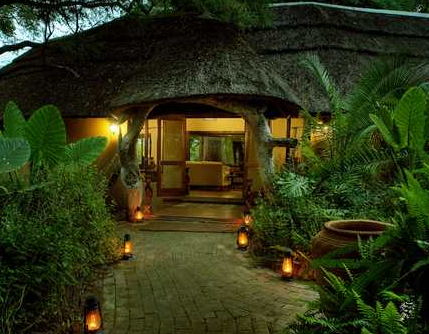 acacias and Mokolwane palms of Brown Hyaena Island, on the edge of the Makgadikgadi Salt Pans, adjacent to the Makgadikgadi-Nxai Pans National Park. Head off after tea in the beautiful afternoon light, for an introductory ride, primarily to match horse and rider, but also your first opportunity to experience the beauty of this magical area. Return to the camp for sundowners followed by dinner and to kraal the horses close by, before the lions of the Kalahari commence their nightly prowling.
acacias and Mokolwane palms of Brown Hyaena Island, on the edge of the Makgadikgadi Salt Pans, adjacent to the Makgadikgadi-Nxai Pans National Park. Head off after tea in the beautiful afternoon light, for an introductory ride, primarily to match horse and rider, but also your first opportunity to experience the beauty of this magical area. Return to the camp for sundowners followed by dinner and to kraal the horses close by, before the lions of the Kalahari commence their nightly prowling.
Day 2 - HORSE RIDING & GAME DRIVE: Up with the dawn, a light breakfast is followed by a long morning ride through the “land of a thousand islands”. Stranded on the ancient lakebed, these sand dunes covered in palm trees are one of the most beautiful and fascinating areas of the Botswana wilderness. At the height of the migration season, the islands and adjoining grasslands are awash with zebra, wildebeest, hartebeest and ostrich – and of course the attendant predators! The white encrusted pans between the islands provides excellent going for the horses, but if there has been a lot of rain then many of these areas will be full of water attracting several species of migratory water birds. Return to 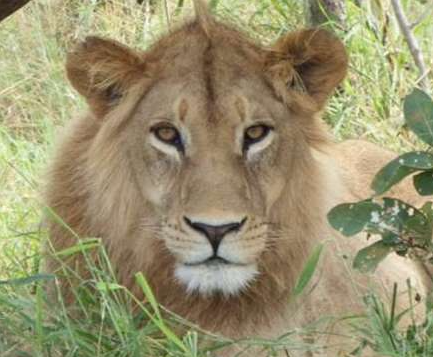 the camp for lunch and rest through the heat of the day in the welcome shade of the camel thorn trees or cool off in the camp swimming pool. After tea, head off by vehicle to see some unique desert species such as springbok, gemsbok, red hartebeest and the elusive brown hyaena; these consummate desert specialists survive in arid areas where both food and water are scarce. The brown hyaena is a timid nocturnal, solitary forager, rarely seen by humans, but in spite of this are very social animals, living in clans of up to 10-12 hyaenas. Enjoy a night game drive back to camp, and with the aid of a spot light, look for nocturnal desert inhabitants such as aardvark, bat eared foxes, aardwolves, porcupine, honey badgers and perhaps even a black maned Kalahari Lion. Arrive at Camp Kalahari in time for dinner.
the camp for lunch and rest through the heat of the day in the welcome shade of the camel thorn trees or cool off in the camp swimming pool. After tea, head off by vehicle to see some unique desert species such as springbok, gemsbok, red hartebeest and the elusive brown hyaena; these consummate desert specialists survive in arid areas where both food and water are scarce. The brown hyaena is a timid nocturnal, solitary forager, rarely seen by humans, but in spite of this are very social animals, living in clans of up to 10-12 hyaenas. Enjoy a night game drive back to camp, and with the aid of a spot light, look for nocturnal desert inhabitants such as aardvark, bat eared foxes, aardwolves, porcupine, honey badgers and perhaps even a black maned Kalahari Lion. Arrive at Camp Kalahari in time for dinner.
Day 3 - XAU XAI: Today is a long ride eastwards to Xau Xai Fly Camp, so an early start is imperative. Be sure to pack a few essentials for the next two days of adventure. The journey takes us away from the edge of the Pans and through the mopane and acacia woodlands interspersed with short grasslands allowing for lovely long, relaxed canters. Whilst the area is rich in birds of prey, bustards, korhaans and numerous other unusual dry woodland bird species; there is also a chance that we will sight kudu and 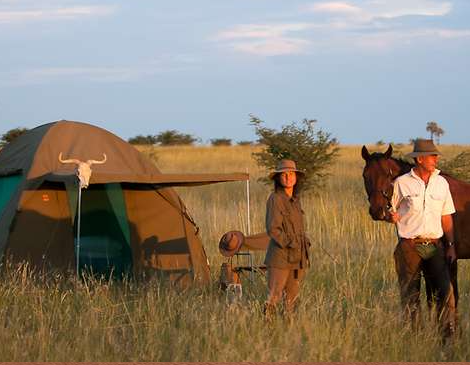 the odd elephant bull. By lunchtime we reach the famous Green’s Baobab proudly positioned alongside the well-travelled Missionary Road, traversed by David Livingstone on his journeys northwards. Break for lunch at the adjacent Gutsa Pan under a stand of palm trees where we may find Stone Age artefacts and the hunting blinds used over millennium by the Bushmen. Siesta through the midday heat and after tea, continue the journey on to Xau Xai Fly Camp. Camp will be made up of comfortable dome tents, a central mess tent, loos and bucket showers. Enjoy a long cool drink as you watch the sunset followed by dinner out under the magnificent Kalahari sky.
the odd elephant bull. By lunchtime we reach the famous Green’s Baobab proudly positioned alongside the well-travelled Missionary Road, traversed by David Livingstone on his journeys northwards. Break for lunch at the adjacent Gutsa Pan under a stand of palm trees where we may find Stone Age artefacts and the hunting blinds used over millennium by the Bushmen. Siesta through the midday heat and after tea, continue the journey on to Xau Xai Fly Camp. Camp will be made up of comfortable dome tents, a central mess tent, loos and bucket showers. Enjoy a long cool drink as you watch the sunset followed by dinner out under the magnificent Kalahari sky.
Day 4 - MEERKATS & WALKING SAFARI: Wake up to a steaming hot cup of coffee and a light breakfast, before heading off on your horses in search of some of the Kalahari’s most fascinating inhabitants, the meerkats. With our horses tethered we will proceed on foot in to the midst of the group. Due to an ongoing habituation programme by Uncharted Africa Safari co. it’s possible for us to get up close and personal with these captivating creatures. Remember, they are not tame – just used to our non-threatening presence. On chilly mornings, you might well find a meerkat snuggling up to you for warmth. Or, in the 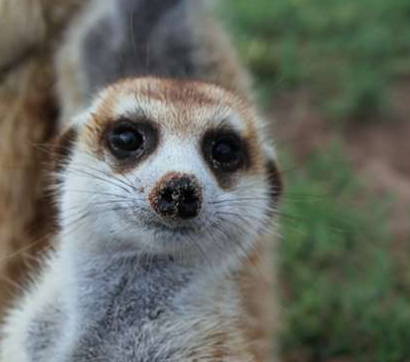 absence of a termite mound or tree, using your head as a sentry lookout post… By spending quality time with these incredibly social, superbly adapted animals, you will be able to see how they interact with each other and their environment. You also get the chance to see the desert through the eyes of a meerkat – which, despite the fact that it’s only a foot off the ground, is a pretty spectacular vantage point, and definitely one of the most special and memorable game experiences you will encounter in Botswana. As the day warms up, leave the meerkats to continue foraging. Mount up and follow the well-worn trails that lead to the resident herds of zebra and large congregations of ostriches attracted to the area by permanent freshwater in hidden waterholes. Return to Xau Xai for lunch, a refreshing shower and a siesta in the shade of the mess tent. In the late afternoon take a walk to a nearby permanent waterhole to look for many of the Kalahari’s special bird species and, as the sun sets, watch the hundreds of sand grouse fly in for a drink. Return to camp for another beautiful evening under a Kalahari sky with a delicious dinner around the campfire.
absence of a termite mound or tree, using your head as a sentry lookout post… By spending quality time with these incredibly social, superbly adapted animals, you will be able to see how they interact with each other and their environment. You also get the chance to see the desert through the eyes of a meerkat – which, despite the fact that it’s only a foot off the ground, is a pretty spectacular vantage point, and definitely one of the most special and memorable game experiences you will encounter in Botswana. As the day warms up, leave the meerkats to continue foraging. Mount up and follow the well-worn trails that lead to the resident herds of zebra and large congregations of ostriches attracted to the area by permanent freshwater in hidden waterholes. Return to Xau Xai for lunch, a refreshing shower and a siesta in the shade of the mess tent. In the late afternoon take a walk to a nearby permanent waterhole to look for many of the Kalahari’s special bird species and, as the sun sets, watch the hundreds of sand grouse fly in for a drink. Return to camp for another beautiful evening under a Kalahari sky with a delicious dinner around the campfire.
Day 5 - RIDE HOME: As the dawn greets this extraordinary landscape and the last of the stars 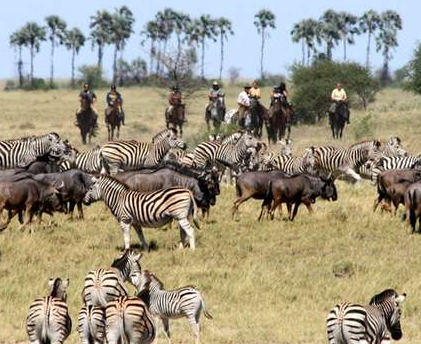 disappear, wake for a light breakfast before mounting up and heading homewards at a fast pace sometimes riding along the edge of the Pans and at other times heading into the woodlands and open grasslands where the zebra and wildebeest graze. The grasslands may be covered as far as the horizon with the vast herds. Canter through them and. with luck, they will join the ride – thousands of zebra cantering in front of you, to the side of you and behind you. Arrive at Camp Kalahari in time for a refreshing shower and lunch. As the sun dips below the horizon and the last light fades, we will be sure to dwell on these amazing past few days. Incredible scenery, memorable wildlife encounters and above all superb riding !
disappear, wake for a light breakfast before mounting up and heading homewards at a fast pace sometimes riding along the edge of the Pans and at other times heading into the woodlands and open grasslands where the zebra and wildebeest graze. The grasslands may be covered as far as the horizon with the vast herds. Canter through them and. with luck, they will join the ride – thousands of zebra cantering in front of you, to the side of you and behind you. Arrive at Camp Kalahari in time for a refreshing shower and lunch. As the sun dips below the horizon and the last light fades, we will be sure to dwell on these amazing past few days. Incredible scenery, memorable wildlife encounters and above all superb riding !
Day 6 - BUSHMEN CULTURAL EXPERIENCE: After breakfast, drive through the bush to the traditionally built Bushmen village; where the community gathers during the day. The huts provide shelter from the harsh Kalahari environment, but are not the 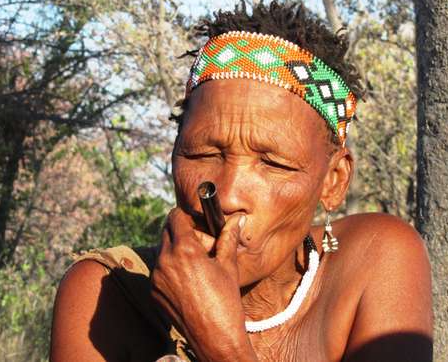 community’s permanent accommodation. On arrival, the elders of the community will meet you in a traditional manner after which you will walk out into the bush with the men, women and children. The focus of the walk will be to provide a gentle introduction to the Kalahari and Bushmen way of life. The group will point out the distinct ecological characteristics of this area and its animal and bird species. Spontaneous gathering and discussions about the uses of plants and wildlife by your Bushmen guides provide the link between culture and wild environment that we seek to offer our guests. Time for one more lunch; before you bid farewell to Camp Kalahari in preparation for your onward journey.
community’s permanent accommodation. On arrival, the elders of the community will meet you in a traditional manner after which you will walk out into the bush with the men, women and children. The focus of the walk will be to provide a gentle introduction to the Kalahari and Bushmen way of life. The group will point out the distinct ecological characteristics of this area and its animal and bird species. Spontaneous gathering and discussions about the uses of plants and wildlife by your Bushmen guides provide the link between culture and wild environment that we seek to offer our guests. Time for one more lunch; before you bid farewell to Camp Kalahari in preparation for your onward journey.
DRY SAFARI (May to August)
Day 1 - CAMP KALAHARI: Arrive by air from Maun. Settle into Camp Kalahari, nestled amongst the  acacias and Mokolwane palms of Brown Hyaena Island, on the edge of the Makgadikgadi Salt Pans, adjacent to the Makgadikgadi-Nxai Pans National Park. Head off after tea in the beautiful afternoon light, for an introductory ride, primarily to match horse and rider, but also your first opportunity to experience the beauty of this magical area. Return to the camp for sundowners followed by dinner and to kraal the horses close by, before the lions of the Kalahari commence their nightly prowling.
acacias and Mokolwane palms of Brown Hyaena Island, on the edge of the Makgadikgadi Salt Pans, adjacent to the Makgadikgadi-Nxai Pans National Park. Head off after tea in the beautiful afternoon light, for an introductory ride, primarily to match horse and rider, but also your first opportunity to experience the beauty of this magical area. Return to the camp for sundowners followed by dinner and to kraal the horses close by, before the lions of the Kalahari commence their nightly prowling.
Day 2 - LAND OF A THOUSAND HILLS: Up with the dawn, a light breakfast is 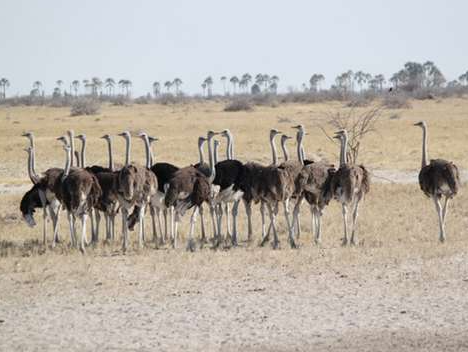 followed by a long morning ride through the “land of a thousand islands”. Stranded on the ancient lakebed, these sand dunes covered in palm trees are one of the most beautiful and fascinating areas of the Botswana wilderness. At the height of the migration season, the islands and adjoining grasslands are awash with zebra, wildebeest, hartebeest and ostrich – and of course the attendant predators ! The white encrusted pans between the islands provides excellent going for the horses. Return to the camp for lunch and rest through the heat of the day in the welcome shade of the camel thorn trees or cool off in the camp swimming pool. After tea, head off to see some unique desert species such as springbok, gemsbok, red hartebeest and the elusive brown hyaena; these consummate desert specialists survive in arid areas where both food and water are scarce. The brown hyaena is a timid nocturnal, solitary forager, rarely seen by humans, but in spite of this, are very social animals, living in clans of up to 10-12 hyaenas. Enjoy a night game drive back to camp, and with the aid of a spot light, look for nocturnal desert inhabitants such as aardvark, bat eared foxes, aardwolves, porcupine, honey badgers and perhaps even a black maned Kalahari lion. Arrive at Camp Kalahari in time for dinner.
followed by a long morning ride through the “land of a thousand islands”. Stranded on the ancient lakebed, these sand dunes covered in palm trees are one of the most beautiful and fascinating areas of the Botswana wilderness. At the height of the migration season, the islands and adjoining grasslands are awash with zebra, wildebeest, hartebeest and ostrich – and of course the attendant predators ! The white encrusted pans between the islands provides excellent going for the horses. Return to the camp for lunch and rest through the heat of the day in the welcome shade of the camel thorn trees or cool off in the camp swimming pool. After tea, head off to see some unique desert species such as springbok, gemsbok, red hartebeest and the elusive brown hyaena; these consummate desert specialists survive in arid areas where both food and water are scarce. The brown hyaena is a timid nocturnal, solitary forager, rarely seen by humans, but in spite of this, are very social animals, living in clans of up to 10-12 hyaenas. Enjoy a night game drive back to camp, and with the aid of a spot light, look for nocturnal desert inhabitants such as aardvark, bat eared foxes, aardwolves, porcupine, honey badgers and perhaps even a black maned Kalahari lion. Arrive at Camp Kalahari in time for dinner.
Day 3 - XAU XAI: Today is a long ride eastwards to Xau Xai Fly Camp, so an early start is imperative. Be sure to pack a few essentials for the next two days of adventure. 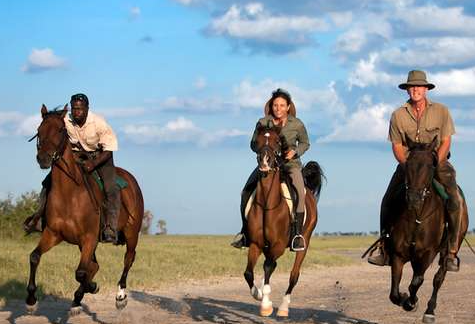 The journey takes us away from the edge of the pans and through the mopane and acacia woodlands interspersed with short grasslands allowing for lovely long canters. Whilst the area is rich in birds of prey, bustards, korhaans and numerous other unusual dry woodland bird species; there is also a chance that we will sight kudu and the odd elephant bull. By lunchtime we reach the famous Green’s Baobab proudly positioned alongside the well- travelled Missionary Road, traversed by David Livingstone on his journeys northwards. The magnificent trunk of this ancient tree is scarred with the initials of early travellers dating back some 150 years thus providing a living testimony to the rich history of this area. Break for lunch at the adjacent Gutsa Pan under a stand of palm trees where we may find Stone Age artefacts and the hunting blinds used over millennium by the Bushmen. Siesta through the midday heat and after tea, continue the journey on to Xau Xai Fly Camp. The camp will be made up of comfortable dome tents, a central mess tent, loos and bucket showers. Enjoy a long cool drink as you watch the sunset followed by dinner out under the magnificent Kalahari sky.
The journey takes us away from the edge of the pans and through the mopane and acacia woodlands interspersed with short grasslands allowing for lovely long canters. Whilst the area is rich in birds of prey, bustards, korhaans and numerous other unusual dry woodland bird species; there is also a chance that we will sight kudu and the odd elephant bull. By lunchtime we reach the famous Green’s Baobab proudly positioned alongside the well- travelled Missionary Road, traversed by David Livingstone on his journeys northwards. The magnificent trunk of this ancient tree is scarred with the initials of early travellers dating back some 150 years thus providing a living testimony to the rich history of this area. Break for lunch at the adjacent Gutsa Pan under a stand of palm trees where we may find Stone Age artefacts and the hunting blinds used over millennium by the Bushmen. Siesta through the midday heat and after tea, continue the journey on to Xau Xai Fly Camp. The camp will be made up of comfortable dome tents, a central mess tent, loos and bucket showers. Enjoy a long cool drink as you watch the sunset followed by dinner out under the magnificent Kalahari sky.
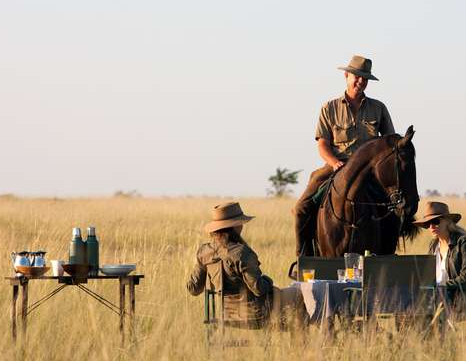
Day 4 - PANS & THE FASCINATING MEERKATS: Wake up to a steaming hot cup of coffee and a light breakfast, before heading off in search of some of the Kalahari’s most fascinating inhabitants, the meerkats. With our horses tethered we will proceed on foot in to the midst of the group. Due to an ongoing habituation programme by Uncharted Africa Safari co. it’s possible for us to get up close and personal with these captivating creatures. Remember, they are not tame – just used to our non-threatening presence. On chilly mornings, you might well find a meerkat snuggling up to you for warmth. Or, in the absence of a termite mound or tree, using your head as a sentry lookout post… By spending quality time with these incredibly social, superbly adapted animals, you will be able to see how they interact with each other and their environment. You also get the chance to see the desert through the eyes of a meerkat – which, despite the fact that it’s only a foot off the ground, is a pretty spectacular vantage point, and definitely one of the most special and memorable game experiences you will encounter in Botswana. As the day warms up, leave the meerkats to continue foraging. Mount up and follow the well-worn trails that lead to the resident herds of zebra and large congregations of ostriches attracted 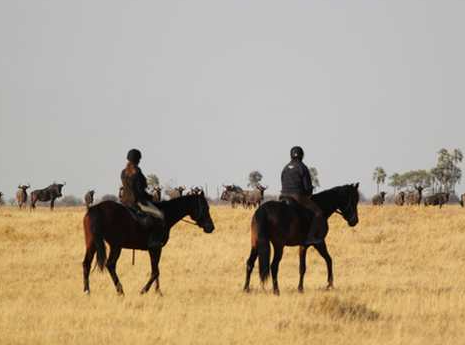 to the area by permanent freshwater in hidden waterholes. Return to Xau Xai for lunch and a refreshing shower. Set off in the late afternoon for one of the greatest adventures imaginable – a ride straight out into the middle of the ancient lakebed ! Eventually all that can be seen is the vast flatness stretching in every direction. Watch the sun set and the stars rise. This is one of the only places in the world where the silence is so complete you can hear the blood circulating through your ears. There is not one visual landmark to be seen and one swiftly loses one’s sense of perspective – 16,000 square kilometres of baking soda void, are inhabited only by you and a few gazillion invisible brine shrimp ! And it is here that we’ll make camp. Sleeping on bedrolls under the silence of a star studded sky !
to the area by permanent freshwater in hidden waterholes. Return to Xau Xai for lunch and a refreshing shower. Set off in the late afternoon for one of the greatest adventures imaginable – a ride straight out into the middle of the ancient lakebed ! Eventually all that can be seen is the vast flatness stretching in every direction. Watch the sun set and the stars rise. This is one of the only places in the world where the silence is so complete you can hear the blood circulating through your ears. There is not one visual landmark to be seen and one swiftly loses one’s sense of perspective – 16,000 square kilometres of baking soda void, are inhabited only by you and a few gazillion invisible brine shrimp ! And it is here that we’ll make camp. Sleeping on bedrolls under the silence of a star studded sky !
Day 5 - RIDE ACROSS THE MOON: Wake up on the moon ! As the dawn greets this extraordinary landscape and the last of the stars disappear, head homewards directly across the pans to Camp Kalahari, we may be lucky enough to see the unusual sight of ostrich deep in the Pans. Out here the the horses love the space and despite the distance travelled already they will be raring to go. It feels as if the fast canters should never end. Arrive at Camp Kalahari in time for a refreshing shower and lunch. As the sun dips below the horizon and the last light fades, we will be sure to dwell on these amazing past few days. Incredible scenery, memorable wildlife encounters and above all superb riding !
Day 6 - KALAHARI BUSHMEN: After breakfast, drive through the bush to the 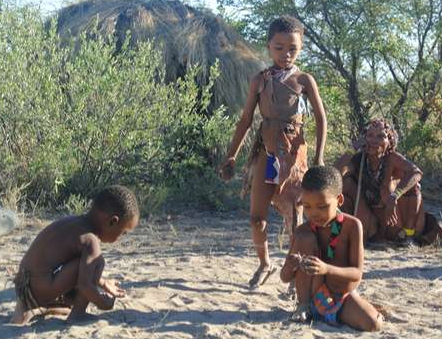 traditionally built Bushmen village; where the community gathers during the day. The huts provide shelter from the harsh Kalahari environment, but are not the community’s permanent accommodation. On arrival, the elders of the community will meet you in a traditional manner after which you will walk out into the bush with the men, women and children. The focus of the walk will be to provide a gentle introduction to the Kalahari and Bushmen way of life. The group will point out the distinct ecological characteristics of this area and its animal and bird species. Spontaneous gathering and discussions about the uses of plants and wildlife by your Bushmen guides provide the link between culture and wild environment that we seek to offer our guests. Time for one more lunch; before you bid farewell to Camp Kalahari in preparation for your onward journey.
traditionally built Bushmen village; where the community gathers during the day. The huts provide shelter from the harsh Kalahari environment, but are not the community’s permanent accommodation. On arrival, the elders of the community will meet you in a traditional manner after which you will walk out into the bush with the men, women and children. The focus of the walk will be to provide a gentle introduction to the Kalahari and Bushmen way of life. The group will point out the distinct ecological characteristics of this area and its animal and bird species. Spontaneous gathering and discussions about the uses of plants and wildlife by your Bushmen guides provide the link between culture and wild environment that we seek to offer our guests. Time for one more lunch; before you bid farewell to Camp Kalahari in preparation for your onward journey.
* The itineraries are indicative and may change depending on weather and local conditions. They depend in particular on the water in the marshes (dry period from May to September when there are fewer animals).
RENDEZ-VOUS:
Aéroport de Maun. Transfert en avion privé jusqu'au camp de base.
SEPARATION:
Transfert en avion privé pour l'aéroport de Maun.
TRANSFERTS:
Les transferts aériens partagés de Maun au camp sont de 350 € par personne et par trajet (minimum 2 personnes). En 2022: 420 € par personne et par trajet (minimum 2 personnes).
VOLS:
Les vols ne sont pas compris dans nos tarifs car il est généralement plus intéressant de réserver vous-même vos vols, un forfait tvols compris revient généralement plus cher avec les commissions d'agences. Nous sommes toutefois à votre disposition pour vous aider à trouver les meilleurs tarifs ou vous proposer un voyage transports compris sur demande: service gratuit.
Avant de réserver vos vols: transmettez nous vos horaires afin de vérifier la concordance avec les horaires des transferts.
NIVEAU: ![]()
Etre très bon cavalier à l'aise aux trois allures en extérieur et en très bonne condition physique. Vous chevauchez dans une zone qui peut être dangereuse, vous devez être capable de réagir rapidement. Vous devez être un cavalier expérimenté avec un esprit d'aventure. Vous passerez généralement quatre à six heures par jour en selle et vous devez donc être en forme. Vous devez être capable de suivre le groupe, à l'aise au trot et au galop rapide sur un terrain varié.
ENCADREMENT:
Guide local + personnel d'assistance parlant anglais.
NOMBRE DE CAVALIERS:
Généralement pas plus de 8 cavaliers.
RYTHME:
Les randonnées varient entre promenades tranquilles exploratoires et informatives à travers la brousse et dans les lits des rivières, et sorties actives avec de nombreux galops qui peuvent être rapides. Vous montez 4 à 6 heures par jour en moyenne.
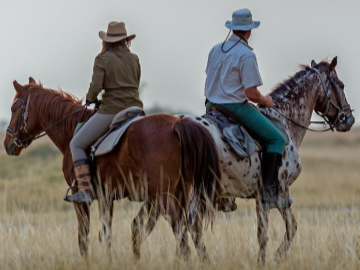 CAVALERIE:
CAVALERIE:
Croisements de pur-sangs, Appaloosas et chevaux de brousse locaux. Ils sont en excellent état et adaptés à leur travail. Les chevaux sont bien dressés ont été soigneusement choisis.
SELLERIE:
Les selles sont principalement des selles sud-africaines confortables.
HEBERGEMENT:
Camp Kalahari est un camp simple, mais confortable avec une traditionnelle bibliothèque en chaume, salon, salle à manger, et une piscine pour les journées chaudes du Kalahari. Pendant la saison humide, Il n’est pas possible de monter à travers les marais l'eau rendant le terrain collant et marécageux, vous pourrez chevaucher en bordure des marécages et faire de nombreux galops dans les prairies tout en découvrant les troupeaux de zèbres en périodes humides. En périodes sèches, il y a moins de zèbres et de gnous mais vous profiterez de galops fantastiques à travers les vastes étendues de croûtes de sel. De votre camp, vous pouvez également faire des balades au clair de lune sous les étoiles. Vous partez à cheval après le thé dans la belle lumière de l'après-midi, pour un tour d'introduction, principalement pour vous adapter à votre cheval et découvrir la beauté de cette zone magique. Retour au camp pour le coucher de soleil, suivi d'un dîner face aux lions du Kalahari.
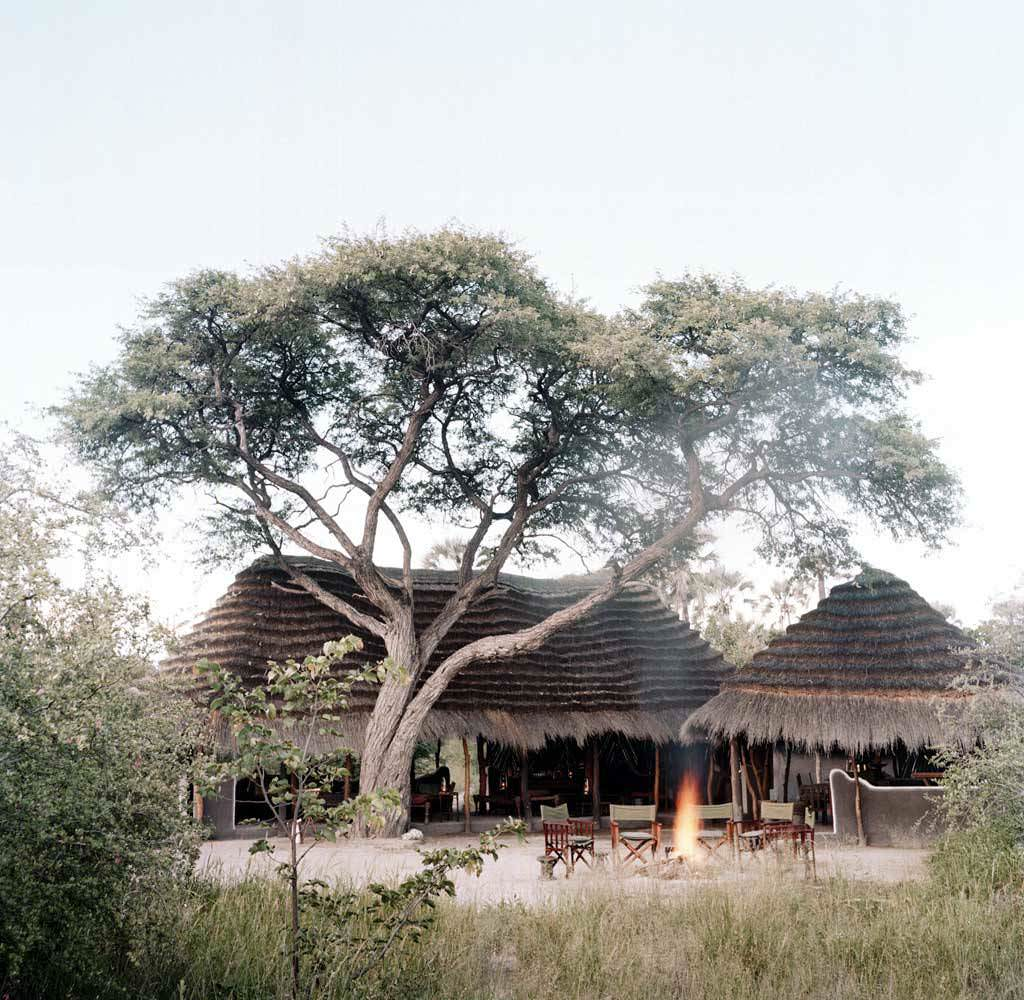 Camp de base 3 nuits sous tente de 2 personnes de 2 lits avec sanitaires privés, draps et linges de toilette fournis.
Camp de base 3 nuits sous tente de 2 personnes de 2 lits avec sanitaires privés, draps et linges de toilette fournis.
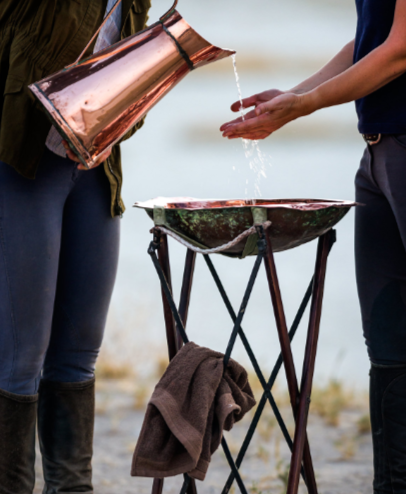 Camp itinérant 2 nuits sous tente de 2 personnes avec douche alimentée par des seaux.
Camp itinérant 2 nuits sous tente de 2 personnes avec douche alimentée par des seaux.
Tentes individuelles disponibles avec supplément si vous voyagez seul(e) et si vous ne souhaitez pas partager la tente (voir tarif).
Le camp de base dispose des tentes à cadre permanent avec une salle de bains privative, tandis que le camp itinérant est plus rustique avec des tentes igloos et des douches au seau.
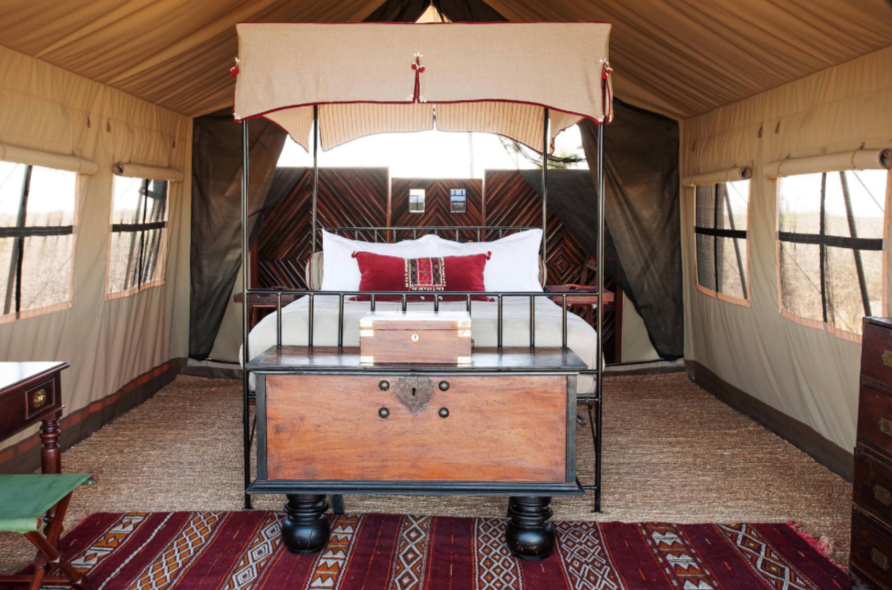
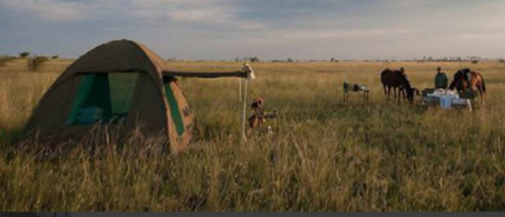
REPAS: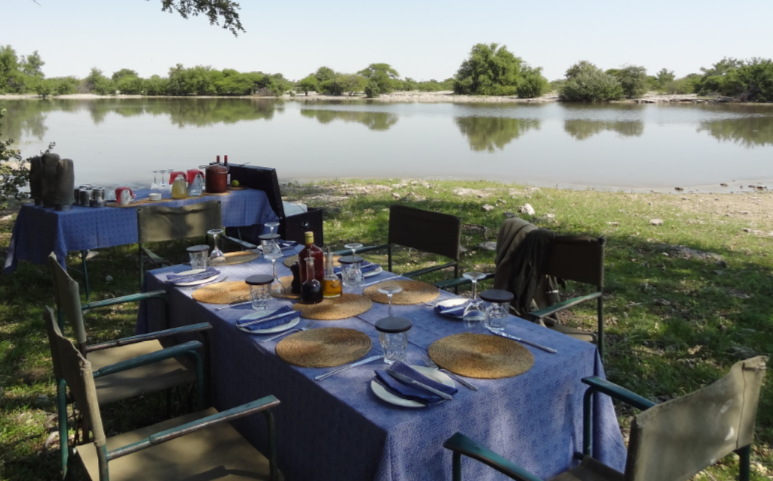
Pris au campement dans une tente mess ou en extérieur.
